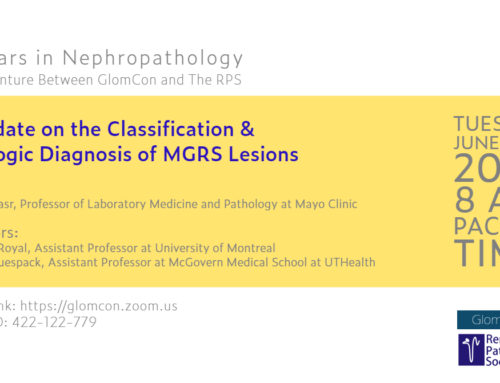CASE BASED DISCUSSION
A Case-Based Approach to Diagnosis and Management of MGRS
In this GlomCon Conference, Dr. Kate Robson led a Case-based Discussion in which she reviewed the evaluation and management of Monoclonal Gammopathy of Renal Significance. Our Moderator’s Notes is derived from her live presentation.


By Dr. Jessica Lapasia
Nephrologist
The Permanente Medical Group
Key points:
Monoclonal Gammopathy
• MGUS = <10% clonal plasma cells in the bone marrow, with approximately 1%/year progression to myeloma.
• Smoldering myeloma = 10-60% clonal plasma cells in the bone marrow, with approximately 10%/year progression to myeloma.
• Active multiple myeloma = >10% clonal plasma cells in the bone marrow, with at least one myeloma-defining event (Calcium elevation, Renal impairment, Anemia, Bone disease.)
• As the burden of clone increases, patients may progress over time from MGUS to smoldering myeloma to active myeloma.
• Monoclonal gammopathy can also cause end-organ effect independent of the size of the clone (as in AL amyloidosis, MIDD, immunotactoid GN, Fanconi syndrome.)
• Several factors can contribute to disease characteristics/burden:
o Rate of immunoglobulin/FLC production
o Structural/chemical properties of immunoglobulin/FLCs
o Host micro-environment (pH, tissue factors)
• SPEP can be negative in patients with clinically significant paraproteinemia. Checking serum immunofixation and serum free light chains should accompany SPEP, whenever paraprotein related kidney disease is suspected.
o Approximately 15% of myeloma cases only produce light chains and SPEP alone may not be sufficient screening for myeloma.
• MGUS plus renal disease does not necessarily equal MGRS and it is important to think of other unrelated conditions (such as DM) contributing to decline in renal impairment. Biopsy is currently our gold standard for diagnosis of MGRS.
- Testing for MGUS/MGRS
• Protein electrophoresis separates proteins by size. This test has limited detection of low level of paraprotein or small size proteins (such as light chains.)
• Immunofixation is more specific and can help identify heavy and light chains as well as help confirm a monoclonal population.
• Kappa light chain is produced at twice the rate of lambda light chain and is cleared more effectively by the kidney; thus, a normal ratio of k/l is <1. In renal impairment, the kappa becomes proportionately elevated due to reduced clearance, and the k/l is more reflective of the rate of production.
• A suggested normal range of free light chain ratio (FLC) in patients with renal impairment is 0.37-3.1. Consider discussion with hematology for cases with a FLC above a ratio of 4-5.Light Chains
• In normal physiology, small amounts of FLC are reabsorbed at the proximal tubule and then lead to endosomal intake and lysosomal degradation.
• In cast nephropathy, a large FLC burden overwhelms the proximal tubule reabsorption capacity and an excess of light chains in the distal tubule bind to Tamm-Horsfall protein and lead to cast formation.
• In light chain proximal tubulopathy, light chains are resistant to proteolysis and are prone to aggregation in the proximal tubule and lead to crystal formation – light chain proximal tubulopathy can be the first clinical presentation of renal disease (and indication for biopsy) in patients with MGUS.
• Consider Fanconi Syndrome in patients with normoglycemic glycosuria, hypophosphatemia, and amino aciduria.Monoclonal Ig Deposition Disease (MIDD)
• Can be light chain (LC), heavy chain (HC), or both (LHC).
• Light chain is the most common, 80% of these are kappa, likely due to its unique physical properties that make it more likely to aggregate.
• Almost all patients have evidence of a dysproteinemia (100% with abnormal FLC, 73% with abnormal SPEP) and more than 50% of patients have multiple myeloma.
• Detectable circulating dysproteinemia can precede or succeed the presentation of kidney disease.
• Significant proportion of patients (>30%) progress to ESKD at 25m follow up, despite targeted treatment.
• Patients who achieve a hematologic response have a much better renal survival.Selected References:
https://www.ncbi.nlm.nih.gov/pubmed/27526705
https://www.ncbi.nlm.nih.gov/pubmed/27927893
https://www.ncbi.nlm.nih.gov/pubmed/27416775
https://www.ncbi.nlm.nih.gov/pubmed/25607108
https://www.ncbi.nlm.nih.gov/pubmed/24108460
https://www.ncbi.nlm.nih.gov/pubmed/18945993
https://www.ncbi.nlm.nih.gov/pubmed/26374607
https://www.ncbi.nlm.nih.gov/pubmed/22156754
https://www.ncbi.nlm.nih.gov/pubmed/30578255



